Birds on Romney Marsh
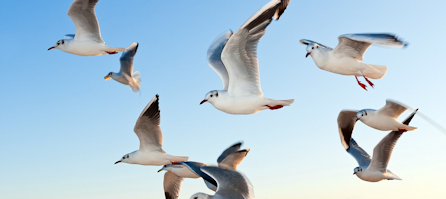

The Bar-Tailed Godwit breeds in the Arctic of Scandinavia and Siberia and is seen in coastal areas of the UK in the winter. The greatest numbers of them are seen between November and February; they stop here on their way south and some of them stay for the winter.
The Bar-Tailed Godwit is usually seen here with its winter plumage, which is grey-brown as shown in the photo, taken on Greatstone Beach in October 2015. However, in spring, it is possible to see them with their rich breeding plumage which is chestnut-coloured.
The Bar-Tailed Godwit is a wading bird with long legs, it also has a long beak. It is approximately 38cm in length and has a wingspan of about 75cm
They feed on invertebrates such as worms, snails and insects.
Bar Talied Godwit

The Common Gull is a smaller verion of the Herring Gull (probably the best known gull in the UK): they can be seen in abundance on the coast, though, despite their name, they are not commonly seen inland. Breeding starts in May. They breed in dunes, coastal marshes, shingle, or rocky ledges. They lay 3 eggs that are incubated for between 22 to 27 days.
The Common Gull has grey upperparts and a white head and underparts, with black tips on the wings. Their legs are yellow/green and their bills are yellow.
They are 38-44cm in length, with a wingspan of 106-125cm. They weigh approximately 400g and have an average lifespan of 10 years.
They eat worms, insects, fish, decaying flesh, and rubbish.
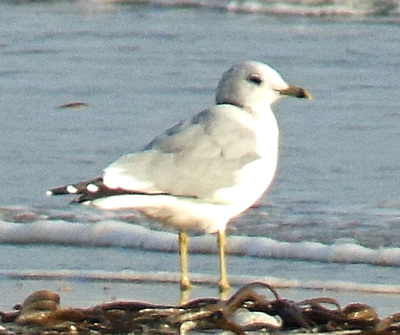
Common Gull

A highly coloured finch with a bright red face and yellow wing patch. Sociable, often breeding in loose colonies, they have a delightful liquid twittering song and call.
Their long fine beaks allow them to extract otherwise inaccessible seeds from thistles and teasels. Increasingly they are visiting birdtables and feeders.
Goldfinches can be seem where there are scattered bushes and trees, rough ground with thistles and other seeding plants. They like orchards, parks, gardens, heathland and commons. Less common in upland areas and most numerous in southern England.
In winter many UK goldfinches migrate as far south as Spain.
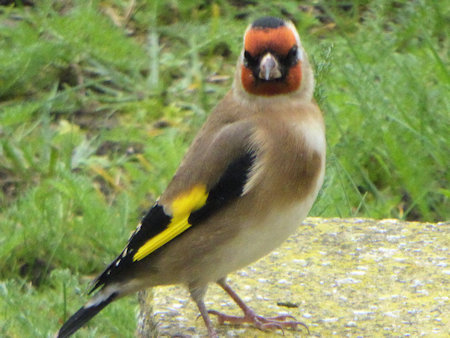
Goldfinch

The Great Crested Grebe is the largest member of the grebe family. They are an elegant waterbird that can be found by lakes, reservoirs and rivers; in winter they can also be found along the coast. The photo, of the Great Crested Grebe, on the right was taken at Greatstone Lake.
Great Crested Grebes are quite distinctive with their ornate head plumes. They are 46-51cm in length with a 59-73cm wingspan. They weigh from 0.9-1.5kgs. The young are easily identifiable by their black and white striped heads, however they lose these markings as they become adults.
They are excellent swimmers and divers. They dive to feed and to escape, preferring this to flying. They mainly feed on fish, and they can pursue their prey underwater.
Great Crested Grebes have an elaborate courtship display where they rise out of the water and shake their heads. They nest at the water's edge, as they can not walk very well with their legs set quite far back. When there are 2, or more, hatchlings the male and females will each choose their favourites to exclusively care for. The young are often sat on their parents backs.
The Great Crested Grebe was almost hunted to extinction in the 19th century, for it's head plumes. The feathers were used to decorate ladies hats and undergarments. The RSPB was set up to help protect this species, which is now, once more, a common site.
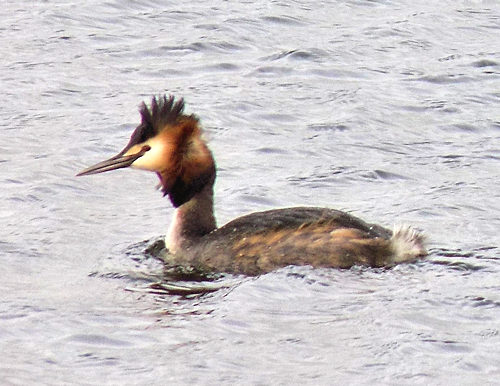
Great Crested Grebe

The Grey Heron is a long-legged wading bird found around water - ponds, lakes, rivers, esturaries or the coast - as shown at Romney Marsh in the photo to the right. The Grey Heron does not migrate so can be seen at any time of year.
Grey Herons are easily recognisable: they stand at about 1m tall, with a long neck and long legs; they have a white head and neck with black crest and black markings that continue down its throat to its belly, a grey body and wings with white underparts and they have a long pinkish/yellow beak. Adults weigh between 1-2 kgs.
They feed in shallow water, mainly on fish, but will also eat small birds, small mammals and amphibians. They can stand with their neck stretched out looking for food, or hunched down, with their neck bent over their chest.
The Grey Heron will nest in tall trees, usually forming a colony with other herons. They breed in Spring, using the same nest year-after-year. They lay between 3-5 eggs. Many juveniles do not survive their first winter; if they do then they will live for approximately 5 years.
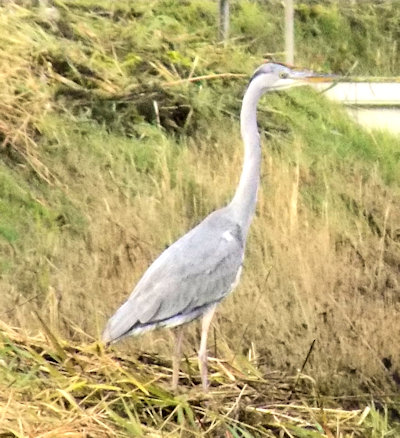
Grey Heron

The Mute Swan is a waterbird; its wild population is migratory, however, European populations are mostly sedentary. There are large numbers in the UK that can be found anywhere there is shallow or slow-moving water, such as on Greatstone Lake as seen in the photo to the right.
The Mute Swan is quieter than other members of the swan family, hence its name!
The Mute Swan is white with a long s-shaped neck. It has an orange bill, with black at the base of it. The Mute Swan flies with its neck extended and has slow, regular beats of its wings. Adults are typically 140-160cm long.
They feed on water plants, insects, and snails.
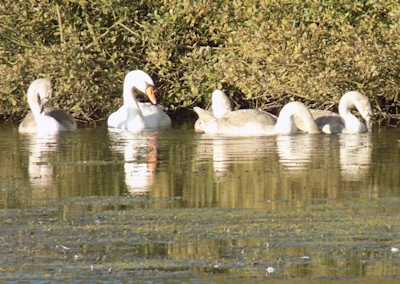
Mute Swans

The Oystercatcher is a wader that can be found around the coast of the UK, as seen in the photo to the right, on Greatstone Beach, however over the last 50 years they have started to move inland and breed on lakes and waterways. It is a noisy bird with a loud 'peeping' call.
Oystercatchers have black wings and head, a white underpart, a red bill and pinkish legs. They are 40-45cm long, with a wingspan of approximately 83cm and weigh about 540g. They have an average lifespan of 12 years.
An oystercatcher eats shellfish, particulalry cockles and mussels.
They are currently classified as an Amber list species for the Birds of Conservation Concern because of a previously decining, though now recovering population.
Oystercatchers

The Pied Wagtail can be found across the UK, most often by water, as seen in the photograph to the right taken on Greatstone Beach, though it can be spotted in most habitats.
Pied Wagtails are small birds, the male is black and white with a long tail that can be seen wagging up and down, the female is similar but greyer. They are approximately 18cm in length, with a wingspan of 25-30cm and they weigh about 25g.
A Pied Wagtail eats insects, predominantly flies and caterpillars, found in fields, lawns and verges. They often call as they fly over their favourite hunting ground to check if a Pied Wagtail is already feeding there.
They start breeding in May and lay 3-7 eggs, which are incubated for 12-14 days.
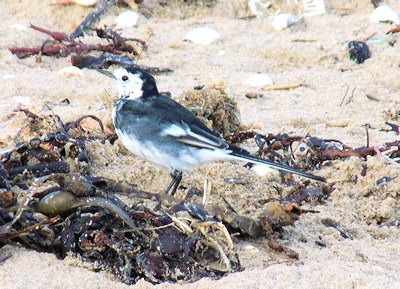
Pied Wagtail

The European Robin, commonly known in the UK as simply the Robin, is the nation's favourite bird. They can be seen all over the country in woodland, parks, hedgerow and gardens; like the photo on the right, taken in a Greatstone garden. They are resident in the UK throughout the year.
The male and female Robins look the similar, with their familiar red breast, face, throat and cheeks, white belly and olive-brown upper parts. Their young do not have a red breast but are spotted with golden brown. This is to protect the juvenile birds from attack in adult disputes. They lose their speckled feathers when they are about 2 to 3 months old.
The adult bird is about 13-14cm in length, with a wingspan of 20-22cm. They weigh between 16 to 22g. They eat worms, insects, seeds and fruit. Robins sing nearly all year round.
The males are aggressively territorial and their attacks can lead to fatalities. The high mortality rate within their first year of life means they have an average life expectancy of 1.1 years, however if they live past the first year they can live up to 19 years.

Robin

Sparrowhawks are small birds of prey with strikingly bright yellow eyes, broad wings, and yellow legs with long talons.
Males are smaller than females with grey upper parts, a streaked orange-brown front, and a slate-grey head on top with an orange-brown face. Females are significantly bigger (by up to 25%) and are streaked with dark brown all over. Their head is also dark brown, with a slight eye stripe. Juveniles look similar to females.
Although well-known as a visitor to garden bird feeding stations, only 10% of Sparrowhawk hunting flights are successful. They use a variety of hunting techniques, but perhaps the most characteristic one is to fly low on the far side of a hedge or fence, before flipping over the top and surprising the birds on the other side.
Some small birds, such as Blue Tit have a specific warning call they give if they spot a Sparrowhawk. Other birds, including other species, can understand this call and also seek cover. The call will also alert us to the nearby presence of a Sparrowhawk!
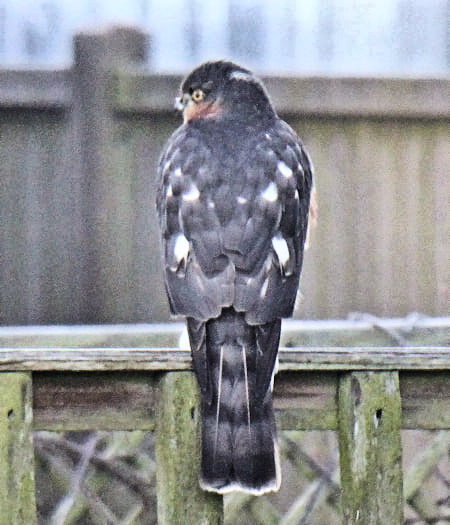
Sparrowhawk (filmed in Greatstone 2022)



